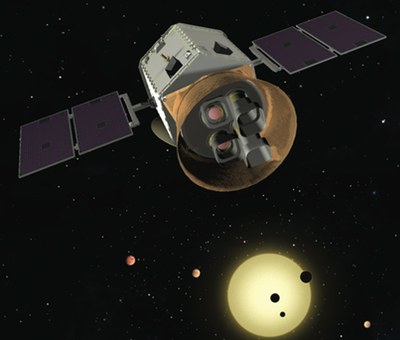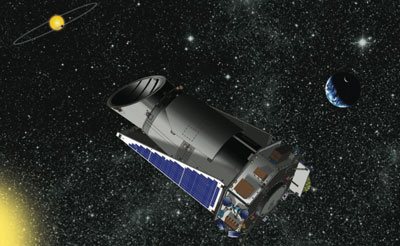Kepler’s second actby Jeff Foust
|
| “A one-meter telescope in space is a pretty good deal. You don’t want to just throw that away,” said Howell. |
The same came be true for space missions as well. In the early 1990s, the Hubble Space Telescope was the butt of comedians’ jokes because of its blurry optics. After servicing missions to correct its optics and perform other upgrades, Hubble has become one of NASA’s most beloved missions in the minds of public, so much so that there was a public outcry ten years ago after NASA cancelled the final Hubble servicing mission, a reaction that fueled the successful effort to restore it. Now, some scientists and engineers are hoping that another NASA mission, all but declared dead last year, can write a comeback story of its own.
K2 ascends
Last August, the future of the Kepler mission looked bleak. The spacecraft had helped revolutionize the study of exoplanets by looking at a single patch of the sky and looking for periodic, minute decreases in the brightness of more than 100,000 stars caused when planets orbiting those stars pass in front of, or transit, them. Scientists analyzing Kepler data have discovered more than 3,500 “planet candidates” and nearly 250 confirmed planets, with many more likely to come as data already collected by Kepler continues to be analyzed.
Such observations, though, require precise pointing, which Kepler accomplished using reaction wheels. Last May, though, the second of four reaction wheels on the spacecraft failed, putting the spacecraft into safe mode. Kepler needs three reaction wheels to maintain proper pointing. In August, project officials said that efforts to get one of the failed wheels working were unsuccessful, putting an end to Kepler observations—at least for its primary mission (see “Kepler seeks a new mission”, The Space Review, August 19, 2013).
There was a glimmer of hope then for the future of the Kepler spacecraft itself, though. At the same time that the project was ending efforts to restore one of the failed reaction wheels, it sent out a call for white papers on alternative uses of Kepler that didn’t require the precise pointing of the original Kepler mission. At the same time, spacecraft engineers determined just how well they could operate the telescope.
“A one-meter telescope in space is a pretty good deal. You don’t want to just throw that away,” said Kepler project scientist Steve Howell at a Kepler town hall meeting during the 223rd meeting of the American Astronomical Society (AAS) outside Washington, DC, last month.
The call for white papers results in 42 detailed submissions, Howell said, which the project incorporated into their planning. Those ideas, and the ongoing spacecraft engineering work, converged on a mission concept late last year dubbed K2. “We’ve figured out a way within the spacecraft limitations and within the science that was listed in those white papers,” he said, “and we’ve developed this K2 mission concept.”
In the K2 mission, the Kepler spacecraft would no longer look at a single patch of the sky, as it did during its original mission, but instead observe four to six fields per year along the ecliptic. In this mode, Kepler is carefully oriented so that pressure exerted by solar photons hitting the spacecraft augments the existing reaction control wheels to balance the spacecraft. That gives the spacecraft pointing stability close to what it could achieve with a full complement of reaction wheels. However, it requires Kepler to point at areas of the sky along the ecliptic, and to change fields every two to three months as it orbits the Sun.
| “Everybody unanimously said that they’ve done a really good job,” said NASA HQ’s Hudgins of the K2 mission concept. |
That will still allow Kepler to search for exoplanets—“we can’t not do exoplanets,” Howell said—but K2 will do a different search. “It won’t be a survey like Kepler. You can’t look at a field for four years,” he said. Instead, the K2 mission will be able to look at planets around M-class stars, where planets that lie in the habitable zones of those planets have short orbits that can be observed in a brief survey. K2 will also look for planets around brighter stars, as well as young and pre-main sequence stars, Howell said.
The K2 science goes beyond exoplanets as well. Howell said Kepler will be able to contribute to studies of star clusters and star formation, studying stellar variability and astroseismology (something the original Kepler mission did as well.) The K2 mission can also support extragalactic science, studying variability of active galactic nuclei and supernovae.
The K2 mission is not a done deal yet, though, although it is building up support. In December, officials at NASA Headquarters approved allowing the K2 mission to participate in the upcoming senior review of NASA astronomy missions planned for this spring, after reviewing the concept. “Everybody unanimously said that they’ve done a really good job,” said Doug Hudgins, exoplanet exploration program scientist at NASA Headquarters, during a presentation at a meeting of the Exoplanet Exploration Program Analysis Group (ExoPAG) immediately before the AAS conference last month. “This is definitively competitive science that should be considered in the senior review in the context in the science cases of the other missions.”
The next step for K2 is to submit a proposal for the senior review, a process where NASA reviews existing missions that have completed their primary missions to determine if the science they are performing is worth continued funding. (This process is similar to, but separate from, the upcoming senior review of planetary science missions also planned for this spring.) K2 will be competing with a number of other astronomy missions for what may be limited funding, depending on NASA’s budget projections for fiscal years 2015 and 2016, the years covered by the senior review.
At the AAS meeting, Howell sought feedback on the K2 mission concept, including the proposed regions of the sky Kepler would look at over the next two years if the mission is funded. “It will really help us sell the mission to senior review, and sell it to the community,” he said.
 TESS will look for exoplanets around nearby stars using the same transiting technique as Kepler. (credit: MIT) |
Transiting missions beyond Kepler
One successful aspect of the Kepler mission, beyond the science it achieved, was that it demonstrated that spacecraft could perform the very precise photometry of stars needed to detect the faint signals created by transiting planets. During a presentation at a history session of the AAS meeting last month, Kepler principal investigator Bill Borucki recalled the long history behind the mission concept that became Kepler, including multiple rejections of mission proposals submitted to NASA’s Discovery program.
“Each time we proposed, the review panel told us why they didn’t like what we were doing, and gave us suggestions for improvement that were enormously helpful,” Borucki recalled. That included demonstrating it was possible to develop photometers about 100 times better than what was previously available to provide the sensitivity needed to detect transiting Earth-like exoplanets. NASA finally selected Kepler in 2001 after four rejections.
The skepticism of space-based transit detections that existed before Kepler (as well as a French spacecraft, CoRoT, that also detected transiting exoplanets), has given way to enthusiasm of the technique. Two missions are under development now, in the US and Europe, that plan to make use of the technique to look for exoplanets.
| “CHEOPS is a follow-up mission, not a discovery mission,” said Benz. “TESS will provide us with a huge number of interesting targets.” |
Last April, NASA selected the Transiting Exoplanet Survey Satellite (TESS) as the agency’s next Explorer-class small astronomy mission. The spacecraft, which has a “launch readiness date” of August 2017, will go into a high Earth orbit to look for exoplanets transiting nearby and bright stars.
“The TESS team often refers to the mission as the ‘people’s telescope,’” said George Ricker of MIT, the principal investigator for the mission, at last month’s ExoPAG meeting. He said that refers to both the payback it provides to the taxpayer by looking for planets around nearby stars, but also to the scientific community, since many planets found by TESS will be well-suited for follow-up observations and characterization by other telescopes.
While both TESS and Kepler look for transiting exoplanets, the missions are different in their scientific aims. “The two missions are really addressing two different questions,” Ricker said. “TESS is really focused on finding the nearest exoplanets, while Kepler has very successfully answered the question of how common are true Earth analogs.”
As NASA develops TESS, ESA is working on its own exoplanet transit observation mission, called the Characterizing Exoplanet Satellite, or CHEOPS. The mission is the first small, or “S-mission” selected by ESA’s science program in late 2012. The mission was originally conceived as a Swiss mission in 2008, Willy Benz of the University of Bern said at the ExoPAG meeting, then was selected from 26 proposals by ESA in 2012 as the first S-class mission.
CHEOPS is different from both TESS and Kepler in that it is not intended to discover exoplanets. “The mission objectives are to search for transits on bright stars already known to host planets,” Benz said. Those observations will help characterize those exoplanets, including determining their size and whether they have atmospheres. “CHEOPS is a follow-up mission, not a discovery mission.”
In that respect, then, TESS and CHEOPS are complementary, not completing, missions. “TESS will provide us with a huge number of interesting targets,” he said. CHEOPS is planned for launch in 2017, although it is still formally in the study phase. Benz said he expected ESA to formally adopt the mission as soon as this month.
Those two missions may be soon joined by a third, more ambitious exoplanet transit mission. ESA will make a decision later this month on its next medium-class science mission, designated M3. The frontrunner for that mission is a proposal called Planetary Transits and Oscillations of Stars, or PLATO. The mission will place 34 small telescopes on a single spacecraft that will be able to observe about half the sky from the Earth-Sun L2 Lagrange point, looking for exoplanet transits as well as study stellar oscillations. Plato could detect Earth-sized exoplanets in the habitable zone around Sun-like stars over the course of its six-year mission. If selected, Plato would launch in the early 2020s.
So, while Kepler’s original mission may be done (although analysis of the data from those observations will continue for several more years), and even if Kepler’s comeback in the form of K2 falls short, some combination of TESS, CHEOPS, and PLATO will carry on the transit observation technique it demonstrated so well to continue the search for and study of exoplanets, continuing the quest of seeking other worlds like the Earth.
